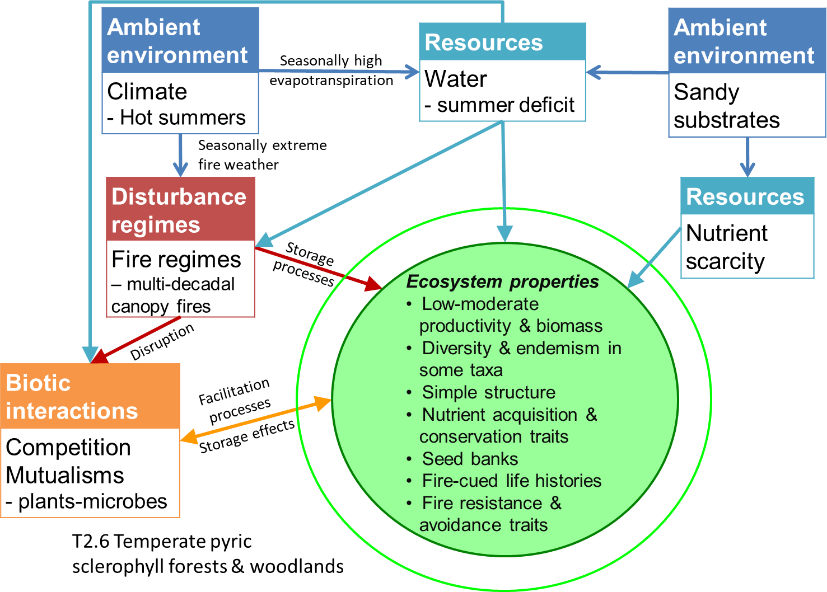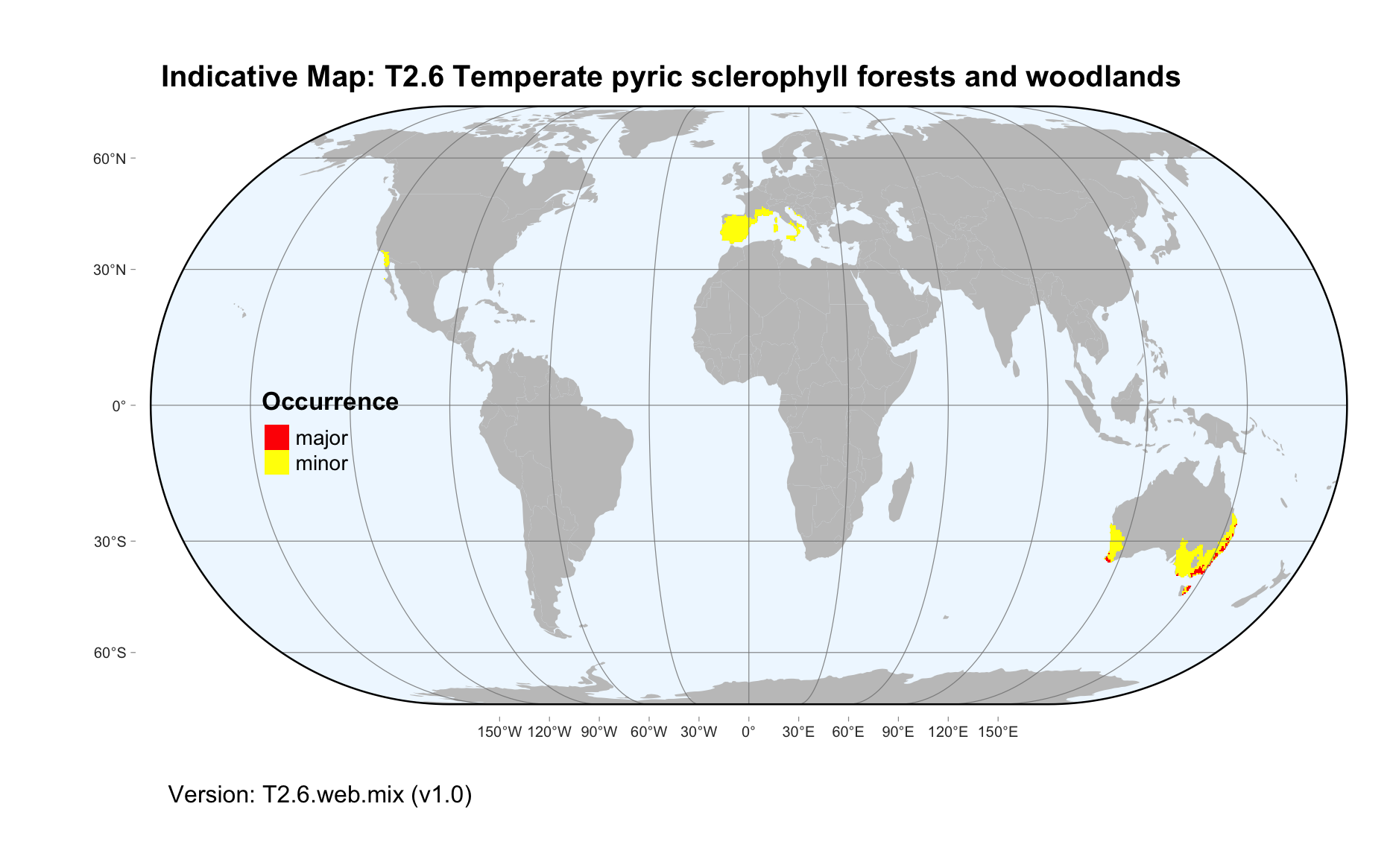Global ecosystem typology
Alternative site for the Global ecosystem typology with additional information for ecosystem profiles and indicative maps.
This site is maintained by jrfep
T2.6 Temperate pyric sclerophyll forests and woodlands
Biome: T2. Temperate-boreal forests and woodlands biome
Contributors:
(texts)
In fire-prone temperate regions, temperate pyric sclerophyll forests are characterised by an open canopy of hard-leaved trees with a shrub layer underneath, sometimes with grasses and forbs. Productivity is limited by seasonal drought, hot summers, and low nutrients in sandy and loamy soils. Some groups of plants, birds, reptiles, and invertebrates have high diversity and uniqueness, many with locally restricted distributions. Plants and animals are adapted for persistence through successive summer droughts and fires and, although sensitive to fire frequency and season, periodic disturbance by fire is critical to maintaining forest diversity.
Key Features
Sclerophyll forests and woodlands in warm climates with winter precipitation and a canopy-fire regime.
Overview of distribution
Temperate regions of Australia, the Mediterranean, and California.
Profile versions
- v1.0 (2020-01-20): DA Keith; F Essl; J Franklin; RC Mac Nally
- v2.0 (2020-05-31): DA Keith; F Essl; J Franklin; R Mac Nally
- v2.01 ():
- v2.1 (2022-04-06): DA Keith; F Essl; J Franklin; R Mac Nally Full profile available at official site
Main references
Selected references for this functional group:
Tozer MG, Simpson CC, Jansens IB, Keith DA (2017) Biogeography of Australia’s dry sclerophyll forests: drought, nutrients and fire Australian vegetation (Ed. DA Keith), pp 314-338. Cambridge University Press, Cambridge. ISBN 978-1-107-11843-0
Barbour M, Keeler-Wolf T, Schoenherr AA (2007) Terrestrial vegetation of California 3rd edition. University of California Press, Berkeley
Diagrammatic assembly model

Maps
Maps are indicative of global distribution patterns are not intended to represent fine-scale patterns. The maps show areas of the world containing major (coloured red) or minor occurrences (coloured yellow) of each ecosystem functional group. See general notes on maps.
There are 2 alternative versions of the indicative map for this functional group, please compare description and sources below.
T2.6.IM.mix_v1.0
Datasets
- EarthEnv-LandCover-v1.0
- Resolve-Ecoregions-2017
Map references
Tuanmu, M.-N. and W. Jetz (2014) A global 1-km consensus land-cover product for biodiversity and ecosystem modeling Global Ecology and Biogeography 23(9):1031–1045 DOI:10.1111/geb.12182
Dinerstein E, Olson D, Joshi A, Vynne C, Burgess ND, Wikramanayake E, Hahn N, Palminteri S, Hedao P, Noss R, Hansen M, Locke H, Ellis EE, Jones B, Barber CV, Hayes R, Kormos C, Martin V, Crist E, Sechrest W, Price L, Baillie JEM, Weeden D, Suckling K, Davis C, Sizer N, Moore R, Thau D, Birch T, Potapov P, Turubanova S, Tyukavina A, de Souza N, Pintea L, Brito JC, Llewellyn Barnekow Lillesø JP, van Breugel P, Graudal L, Voge M, Al-Shammari KF, Saleem M (2017) An Ecoregion-Based Approach to Protecting Half the Terrestrial Realm, BioScience 67: 534–545. DOI:10.1093/biosci/bix014. Data-set available on-line
T2.6.web.mix_v1.0

Datasets
- Resolve-Ecoregions-2017
- EarthEnv-LandCover-v1.0
Map references
Dinerstein E, Olson D, Joshi A, Vynne C, Burgess ND, Wikramanayake E, Hahn N, Palminteri S, Hedao P, Noss R, Hansen M, Locke H, Ellis EE, Jones B, Barber CV, Hayes R, Kormos C, Martin V, Crist E, Sechrest W, Price L, Baillie JEM, Weeden D, Suckling K, Davis C, Sizer N, Moore R, Thau D, Birch T, Potapov P, Turubanova S, Tyukavina A, de Souza N, Pintea L, Brito JC, Llewellyn Barnekow Lillesø JP, van Breugel P, Graudal L, Voge M, Al-Shammari KF, Saleem M (2017) An Ecoregion-Based Approach to Protecting Half the Terrestrial Realm, BioScience 67: 534–545. DOI:10.1093/biosci/bix014. Data-set available on-line
Tuanmu, M.-N. and W. Jetz (2014) A global 1-km consensus land-cover product for biodiversity and ecosystem modeling Global Ecology and Biogeography 23(9):1031–1045 DOI:10.1111/geb.12182
Check: the Glossary / Profile structure / the public document